[Note: Figures 2-11 are available in Appendices]
Introduction
Powerful operating systems, fast connections, and immense storage have enabled mobile technology to stimulate positive affectivity, deep engagement, and enhanced motivation (Imamyartha et al., 2021; Kukulska-Hulme & Viberg, 2017). In the same vein, mobile instant messengers (MIM) can offer valuable educational advantages to empower collaborative language learning and foster stronger engagement (Alshaibani & Qusti, 2020; Lai, 2016). However, learners still require encouragement and guidance to gain the utmost advantage of mobile technologies (Hu et al., 2019), especially because the engagement in mobile learning is driven by psychological, emotional, and behavioral dynamics (Dixson, 2010; Taheri et al., 2019; Zou et al., 2018). As a corollary, teachers need to grasp these dynamics and develop relevant pedagogical approaches and skills to optimize mobile technologies (Diao & Hedberg, 2020).
Although recent literature has reported solid insights into MIM-mediated instruction, there remains a gapping void concerning the profiles of students’ online learning engagement and how this relates to their learning achievement. Furthermore, student-teacher relational authenticity in MIM-mediated environment remains underexplored, despite its influence on learning performance (Frego, 2006). This study warrants its merit to research in mobile language learning on two grounds. First, due to its seamless integration, mobile technology can contribute to authentic, contextual learning (Kukulska-Hulme & Viberg, 2017). On the methodological ground, employing mixed method research will lead to a more complete and balanced understanding of the pedagogical potentials of MIM relationship between student-teacher relational authenticity and the psychometrics of their learning engagement. This will aid in rethinking the nature of MIM-mediated instruction.
Literature Review
Learners’ performance in MIM-mediated environment
As research on MIM has developed, it has taken over pivotal roles in education. MIMs, such as WhatsApp and Telegram, are capable of empowering students in higher education to perform complex cognition and language tasks (Imamyartha et al., 2022; Ke, 2010). This is attributable to its function as a learning management system to support extensive reflection and consolidation of learning (Annamalai, 2019; Çetinkaya & Sütçü, 2018). These roles demonstrate MIM’s functionality from mediating multimodal communication to fostering the co-construction of knowledge as language learners are taught to reflect on and refine their understanding (Kukulska-Hulme & Viberg, 2017).
Another research area that has also developed recently is related to the teaching of vocabulary. Recruiting students with basic-intermediate proficiency, Ankeny (2019) reported on vocabulary instruction in an Intensive English Program (IEP) through repeated group chats focusing on the meaning and word class of academic lexis. The research suggested that explicit vocabulary instruction could be enhanced by a pedagogically sound use of MIM. This is in line with Tragant et al. (2022) who pointed out that MIM provides diverse input to keep college EFL learners engaged in using the target language both for on-task and off-task purposes. Documenting the pedagogical values of WhatsApp over Facebook, Çetinkaya and Sütçü (2018) underscored the exciting moments of being engaged in mobile vocabulary instruction, leading to stronger retention and awareness of academic vocabulary as documented by their pre-and post-test data.
As a social media, MIM has been shown to serve as a boundary-crossing object by allowing students to collaborate across settings. Using the concept of boundary crossing, Gachago et al., (2015) in their study in an African higher education setting concluded that MIM facilitates reflection, collaboration, and students’ ownership of learning. The last item includes not only informal but also formal open distance learning environments. Tragant et al., (2022) reported similar findings in a Spanish EFL setting by documenting the authentic portrayals of learners’ social interaction and intensive learning engagement across different language tasks. To a large extent, this is because MIM can power students’ capacity by encouraging knowledge co-construction through shared reflection, discussion, and peer evaluation. These technological and socioconstructivist aspects of MIM have been discovered to be valuable resources for EFL learners. Experimental research by Imamyartha et al. (2021) in an Indonesian EFL setting demonstrates that learners in MIM-mediated instruction outperform their counterparts in LMS-mediated instruction with respect to learning engagement, emotional intelligence, and language learning motivation.
These studies have documented the values of MIM to establish not only an engaging, but also empowering environment to support learners’ performance, regardless of their language proficiency level. The versatility for navigating between the social and academic discourses via mobile learning has arisen as a perfect fit for today’s learners as Generation Z who are continuously connected and want to obtain answers quicker and easier (Du, 2015). As socioconstructivism becomes increasingly prominent in online learning, understanding the shifting of autonomy and agency between teachers and students will contribute to discovering more socio-constructivist potentials of MIM.
Existential and relational authenticity in online learning
Participatory learning has become increasingly more prominent due to the rise of MIM to promote students’ autonomy and learning ownership. This is in accordance with Maor (2003) who investigated the roles of teachers in scaffolding socio-constructivist online learning. One of these roles is that of the social hat of teachers which requires them to understand the human dimensions of learning, such as the nature of communication, the magnitude of trust between interactants, and affective support between teacher and students.
The current study is built on the notion of authenticity proposed by Starr (2008) who conceptualized authenticity as constant self-discovery through which one strives to discover one’s true self through values, beliefs, words, and actions. Once authenticity is established and sustained, an individual will gain a sense of empowerment and enhanced self-efficacy which helps to develop an ambient environment, balanced power, and genuine interaction as the basis for improved well-being and co-construction of knowledge (Frego, 2006; Starr, 2008). Not only is authentic engagement relational, but it is also existential since it taps into the state of being. In Levering's (2010) work on existential authenticity, being truly oneself was defined as being happy and content. Students and teachers in online instruction situations are no exception to this fundamental human quest based on the emotional, psychological, and cognitive factors they both encounter (Kukulska-Hulme & Viberg, 2017; van der Spoel et al., 2020),
In an online environment where imagined and actual selves are continuously present and collide with each other, deploying existential and relational authenticity as an analysis framework for collaborative mobile language learning is valuable to gain a deeper understanding of learners’ interactional patterns and their resultant engagement. However, to date, little research has been dedicated to studying the authenticity in an online context. One exception is the study by Rambe & Mkono (2019). Focusing on the academic consultation in a WhatsApp-mediated environment, they documented the existential and relational authenticity in postgraduate students’ supervision. Their research showed how WhatsApp could encourage students to conceal their true selves in establishing an authentic relationship with their supervisor. WhatsApp has shifted the power hierarchy dominated by instructors towards more intensive participation from students. Their findings acknowledged the possibility of using the advantages of WhatsApp (repeated lettering, emoticons, textese, and images) to negotiate and develop more humanistic relationships, without undermining the supervisor’s authority. Unfortunately, given the essentials of positive bonding between teachers and students, and among teachers, to develop meaningful online collaborative learning (Abidin et al., 2021; Maor, 2003), no research has taken the initiative to examine the potential of WhatsApp, or any other MIM platform, to engage students and teachers in authentic relationship within EFL contexts.
MIM as platform for team-based mobile learning
In comparison to computer-mediated communication (CMC), mobile-mediated communication (MMC) appears to be a better fit for today’s language learners for they are always ‘on the move’. They have more chances of encountering unique language needs and exposure to specific language beyond the class walls while experiencing informal connections to speakers all over the globe (Kukulska‐hulme et al., 2017). Current literature has also highlighted the superiority of WhatsApp as a form of MMC over other types of CMC, e.g., Facebook, in terms of seamless integration, values of interaction, and functionality to keep learners engaged in language learning (Andujar & Salaberri-Ramiro, 2019; Çetinkaya & Sütçü, 2018).
Recent discussions on the educational advantages of MIM have documented its coherence with student-centric authentic language learning (Andujar & Salaberri-Ramiro, 2019; Cremades et al., 2019). This is associated with linguistic gains, higher motivation, and stronger interpersonal bonding within the continuum of formal and communicative language learning (Alshaibani & Qusti, 2020; Çetinkaya & Sütçü, 2018; Tragant et al., 2020). Within the social spheres of language learning, WhatsApp offers unique interactivity due to multimodal artifacts and stylized written discourse, and in quasi-synchronous discourse (Tragant et al., 2020). In addition to these cognitive advantages, WhatsApp also generates more excitement and interest than Facebook due to the environment connecting participants (Andujar & Salaberri-Ramiro, 2019; Rambe & Mkono, 2019).
With wide access to learning resources, WhatsApp empowers them to gain the creative language learning, which is perceived as a sporadic learning experience (Gachago et al., 2015). This personalized learning can become increasingly intensive as they gain more confidence and autonomy through shared reflection on their learning progress (Lai, 2016; Tragant et al., 2022). Furthermore, the flexibility and personalization fit second language acquisition (SLA) principles in that mobile learning affords comprehensive input, comprehensive output, noticing of language, collaborative negotiation of meaning, and peer feedback (Lin et al., 2019).
By examining the magnitude of learners’ engagement in mobile learning and the resultant interactional patterns, we believe that this inquiry is useful in helping teachers to understand and prepare language learners’ mentality before they live the target language in a mobile environment. In the view of the underexplored correlation between language learners’ engagement, authentic learning environment, and the pedagogical potential of low-cost ubiquitous mobile technology, this study examines the following questions:
- To what extent do the students engage in TBML to accomplish learning tasks?
- Can the students’ engagement in TBML significantly predict their language learning achievement?
- How does TBML support the social construction of existential and relational authenticity between students and teacher?
Methodology
Research setting and participants
Employing netnography design (Rambe & Mkono, 2019), an adaptation of an ethnographic study to an online setting, and a survey, this study took place for sixteen weeks from February to July 2020. It recruited 222 Indonesian college students enrolled in seven classes across four different courses: English for Nursing, English for Science Education, Intensive Listening, and Introduction to Paragraph Writing. All courses were carried out online with the aid of a university Moodle LMS and WhatsApp as an MIM. MIM became prominent throughout the semester to facilitate (quasi-) synchronous communication and the distribution of multimodal learning artifacts. The first author was the instructor in all courses and is referred to as “the teacher”. The teacher informed the research objective and gained students’ consent before the research began. The online survey examined students’ learning engagement and learning achievement, while the ethnographic design aimed at analyzing the existential and relational authenticity based on the teacher and students’ MIM exchanges. The students were mostly at an A2 (basic user) and B1 (independent user) in reference to the CEFR (Common European Framework of Reference) scale (Council of Europe, 2001). The Table below shows the students’ demographics.

Table 1. Students’ demographics
Research procedure
The teacher divided each class into small chat groups or teams with four to five students assigned randomly, resulting in the formation of a class chat room and group chat rooms. These chat rooms facilitated on-tasks communication as the teacher encouraged consultation and discussion after class. The teacher took part in the MIM exchanges with the students throughout the term which enabled him to access natural exchanges as the portraits of students’ lived experiences (Rambe & Mkono, 2019).
We adopted the team-based mobile learning (TBML) framework designed by Zhu & Wang (2020). It involves four instructional elements: a) permanent team division, b) readiness empowerment, c) application activity, and d) peer assessment. In agreement with Kukulska-Hulme & Lee (2020), the framework fits collaborative mobile learning in that TBML aims at establishing holistic student-centered learning with rich learning materials and e-resources. Following the abovementioned lines of thought, the present study operationalized TBML as shown in Figure 1.
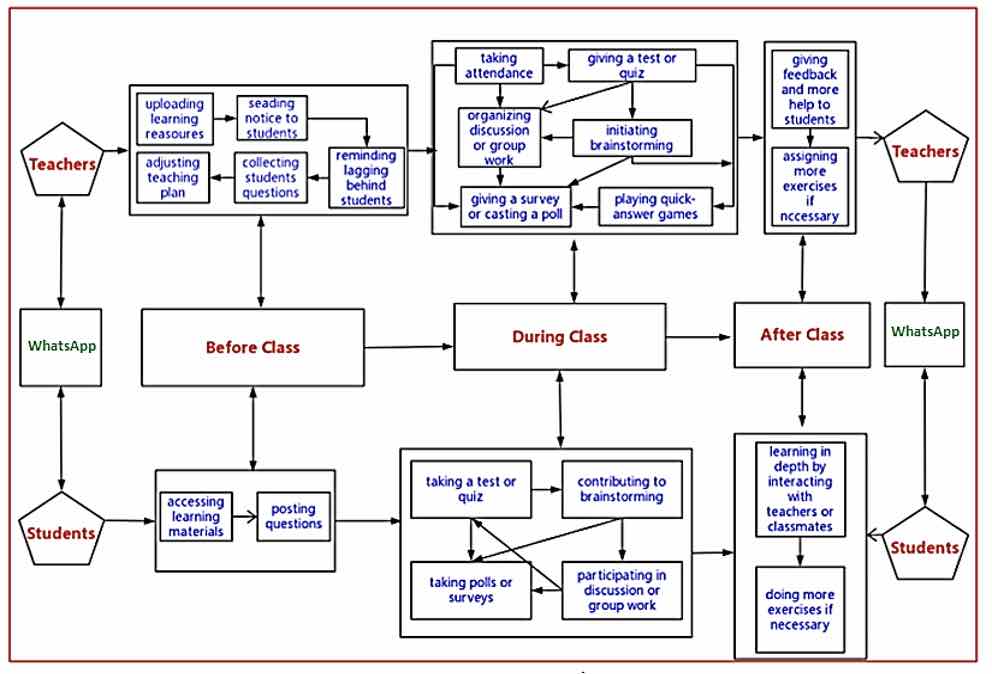
Figure 1: Typical learning activities in TBML
As shown in Figure 1, we integrate WhatsApp before, during, and after instruction. This allows students as members of a learning community to gain more learning autonomy to fit their learning strategy and determine the e-learning resources most relevant to their needs. In addition, it facilitates students’ collaboration as the medium for communicating meaningful ideas.
The teacher mainly used English during the interaction to stimulate active language use among students, yet they had full authority to opt for the language to use since this did not determine their grades. Linguistic inaccuracy was not addressed by the teacher, so only negotiation of meaning was brought into focus. This aimed at creating space to maintain students’ authentic engagement and active language use without concern over mistakes. Learning tasks across courses mainly tapped upon discussion and reflection on ideas concerning real-life issues. These authentic tasks were also enriched with disciplinary content relevant to the student’s major.
The teacher’s instructional philosophy, academic authority, and discourse style (e.g., language use and communicative intent) could have affected his relationship with the students. Instead of treating group discussion as the transmission of knowledge, the teacher managed group discussion as a supportive environment for open dialogue, democratic engagement, and authentic language learning experiences. As such, the teacher was immersed in the meaning-making of the content shared with the students and providing instructional support as facilitator and partner. MIM-mediated environment functioned as a social conduit for instruction-oriented experiences. These included the promotion of academic interaction, management of tasks and learning resources, sharing feedback, monitoring students’ progress, and even humorous exchanges related to the tasks.
The teacher was aware that his academic position could have affected his interaction with the students. For example, students in Indonesia tend to show markedly different attitudes to teachers in common academic settings, i.e., face-to-face classes, where somewhat conservative socio-academic cultures breed reverence for university teachers. The teacher-students relationship in the study can be perceived as in student-centered style, where the teacher maintained his positionality as a partner to maintain a friendly yet professional rapport. The student-teacher relationship should be conceived in the light of using MIM within an academic context where students had the access to peers, teacher, and the learning community as information sources. Group culture and prior familiarity could have influenced the interactions in TBML. These students already recognized each other as collaborators and peers in other courses. The teacher, however, was more acquainted with English Education students since he taught them in several courses. Both parties thus were part of a cohesive academic community.
Data collection and analysis
Quantitative data
The authors chose Dixson’s (2010) online learning engagement (OLE) questionnaire for measuring students’ engagement since it was built on Student Course Engagement Questionnaire (SCEQ) and Classroom Survey of Student Engagement (CLASSE). Both foundations allowed OLE questionnaire to capture emotional engagement, performance engagement, participation engagement, and skills engagement, which fits well with the self-regulated learning, collaboration, and knowledge co-construction embedded in TBML (Zhu & Wang, 2020). The OLE questionnaire was also adapted from Rubric for Assessing Interactive Qualities in Distance Courses (RAIQDC) to cater to technology-enhanced learning processes. Furthermore, the authors considered Dixson’s (2010) questionnaire relevant to the present study as it measured holistic cognitive and affective drives to online learning achievement (Wang et al., 2013). In this regard, the questionnaire involving 5-point Likert scale addressed self-regulated learning, technology self-efficacy, motivation, perceived task value, and performance, which constituted the reliable antecedents to online learning achievement.
The survey items were pertinent to skills engagement (staying up on readings, putting forth effort, e.g., “I study through WhatsApp discussion on a regular basis”); emotional engagement (making the course interesting, applying it to personal life, e.g., “I really desire to learn the course material and exercise through WhatsApp discussion”); participation/interaction engagement (having fun, participating actively in small group discussions, e.g., “I help fellow students in WhatsApp discussion and exercises”); and performance engagement (doing well on tests, getting a good grade, e.g., “I get a good grade on the exercises in WhatsApp discussion”). The translated version reached α 0.927, with all 20 translated items having satisfactory internal validity (p<.05). With the aid of SPSS 25, descriptive statistics were administered to identify the extent of online learning engagement.
The data on students’ learning achievement was derived from the course final examinations administered by the teacher. All courses were designed to develop students’ academic English proficiency. The difference was English for Nursingand English for Science Education involved all four language skills, while Introduction to Paragraph Writing only focused on written communication. Concerning final assessment, the former courses involved multiple-choice tests of vocabulary, reading, grammar, and written communication. The writing course employed explanatory paragraph writing assessed in terms of content quality, organization of ideas, effective use of vocabulary, mechanics accuracy, and language accuracy. The final examination for the Intensive Listening course was adapted from TOEFL listening sections by involving multiple-choice questions on short recordings and long dialogue as well as a monologue. Multiple linear regression analysis was operative to measure the explanatory power of OLE towards students’ learning achievement.
Qualitative data
Adopting qualitative interpretive analysis (Kern, 2012), this study collected data from two sources: teacher and students’ chats via WhatsApp in both chat rooms; and the students’ written reflections at the end of the courses. The former was devoted to gaining actual portrayals of students’ behavior, learning engagement, and student-teacher interactions, while the latter guided the interpretations of the chat archives by relying on students’ voices. The teacher conducted online observation on chat archives and posts, which comprised a discourse corpus integrating texts, emoticons, stickers, videos, audio recordings, and hypermedia.
Following Cunha et al., (2016), qualitative data collection was supported by conversational analysis and discursive interactionism. Communicative interaction is pertinent to allocution (who says what to whom, interlocution (exchange of information), and interaction (the influence interlocutor poses on another). These frameworks enabled a close analysis of how the interaction and rules of interaction among students and between students and teachers developed over time. Upon managing the data, the first author exported the chats from his smartphone and converted these into Microsoft Word documents, with all messages numbered. The authors then manually sorted these chats for exchanges relevant to task accomplishment or constituent to part of a conversation (e.g., multiple exchanges related to humor).
Braun & Clarke's (2006) model of thematic analysis guided the data interpretation by examining the naturally occurring themes in online learning engagement and relational authenticity. The authors first analyzed archived WhatsAppexchanges and written reflections. Subsequently, we sorted the data and looked for common codes which portrayed the social construction as well as the negotiation of relational authenticity between interactants. Afterward, a close review was applied to the existing codes to identify significant themes. Once interim themes were formulated and finally agreed upon by the research team, both a discussion and conclusion were drawn. To ensure rigor, we attached samples of exchanges to provide thick descriptions and add to the verisimilitude of the findings. This was meant to transfer readers to an authentic setting in which students’ unique world and lived experiences arose (Creswell & Miller, 2020).
Findings
Quantitative data
High level of online learning engagement
Our first analysis showed considerable learning engagement mediated by WhatsApp. An average of 4.2749 was identified in the overall online learning engagement. This was mirrored in each dimension of online learning engagement as students monitored their learning, contributed to discussions and individual assignments, helped their peers, and made sense of the learning engagement. As regards the online learning skills, they reported extensive monitoring and engagement in online discussion both during and after class hours (M=4.3367, SE=.03512, SD=.52330). This knowledge co-construction helped to better organize their learning and determine important points of the lesson. In addition, these data confirmed that discussion and resultant comments to teacher and peer’s responses were valuable to developing a learning community. Students’ participation was also found very intensive (M=4.3438, SE=.03858, SD =.57485). As students engaged in discussion, individual and group performance were maintained at a high intensity as evident in the discussion, collaboration, and perceived language ability (M=4.1982, SE=.03992, SD=.59473). The development of a learning community as an arena for shared meaning has triggered strong emotional engagement (M=4.2207, SE=03548, SD=.52871).
Moderate explanatory power of OLE towards learning achievement
Multiple linear regression analysis examined the explanatory power of OLE along with its trait-specific dimensions, i.e., skills, emotion, participation, and performance, towards the students’ learning achievement. The analysis results showed an Adjusted R square of 0.63. This moderate explanatory power meant that students’ online learning engagement could predict 63% of their learning achievement, while the remaining 37% was driven by extraneous variables. However, the performance dimension was excluded from the regression model. One reasonable justification was that this dimension was redundant with the dependent variable, learning achievement, in that both pertained to students’ learning gains, whether perceived by self-assessment using the performance descriptors in the questionnaire or measured by the assessment batteries in the respective courses. In addition, ANOVA documented F 4.746 and p 0.001, implying that the overall OLE and the trait-specific variables can accurately predict learning achievement. Of the four variables included, three were identified to have significant coefficients. These were online learning skills (F -3.018 and p 0.003), emotion engagement (F -3.181 and p 0.002), and OLE (F 2.472 and p 0.014). These statistics concluded that overall, OLE and particularly learning skills, as well as emotional experiences could significantly predict students’ learning achievement.
Qualitative data
This section highlights three themes documenting college English learners’ social construction of existential and relational authenticity in their online learning engagement. Each theme was found in a particular series of learning episodes. All participant names are pseudonyms.
Trials and triumph as the vehicle for self-disclosure
This theme was found in the learning episodes in the two non-English majors. We first reported our findings in one of the English for Science Education classes. These learning episodes described students’ engagement in a discussion on Trash Management. The task required them to match a set of paragraphs with several audio recordings.
The group members shared their written transcription of each recording as they progressed with the task. We could see in Figure 2 that language inaccuracies were consistent, indicated by inaccurate grammatical features in students’ postings or replies and the absence of punctuation in the transcriptions. However, these inaccuracies did not impede communication, nor did they interfere the accomplishment of the task.
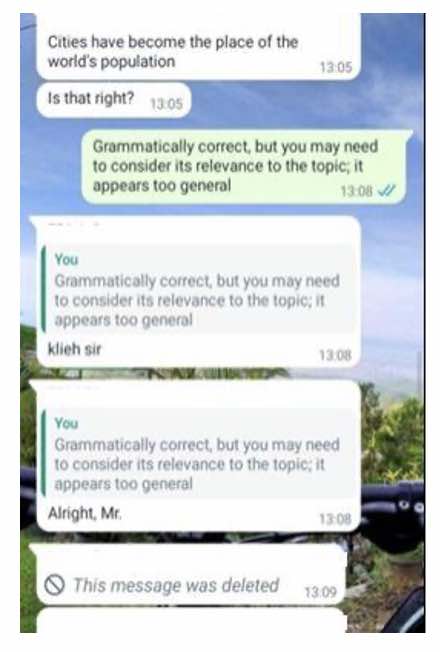
Figure 2: Student hardly grasped task procedure
Different proficiency levels determined how much students grasped learning tasks. Instead of impeding task accomplishment, suboptimal proficiency added to the meaningful language use for on-task purposes. In Figure 2, after stating that she was loading she restated herself by writing “i mean the record”, then she further showed that she hardly grasped the instruction when she later clarified, “i mean that my self still loading”, to which another member immediately responded by clarifying the procedure. This expression was not only transactional, but also relational since she meant it to be jocular, particularly indicated by the emoticon using numerical and alphabetical symbols (i.e., ,: v). These episodes of synchronous communication helped students to sustain learning negotiation by sharing their ideas and emotions. In line with this finding, on student, Alice, mentioned that “WhatsApp group was very helpful since [she] could receive feedback instantly. Students were also able to share their ideas and help each other”. Another student, Betty, mentioned that the benefit of MIM discussion led to “more active participation as [students] got more engaged in the lesson, so [they] could improve [their]) English”.
The following stories in the English for Nursing course show how the students collaborated in a writing task involving revision of content, organization, vocabulary, and language. Each member made contributions to different parts of the task in a stage-managed fashion. Complying with the prompt, these students discussed a possible proper title for the paragraph, and then gradually addressed the organization and language elements (see Figure 3).
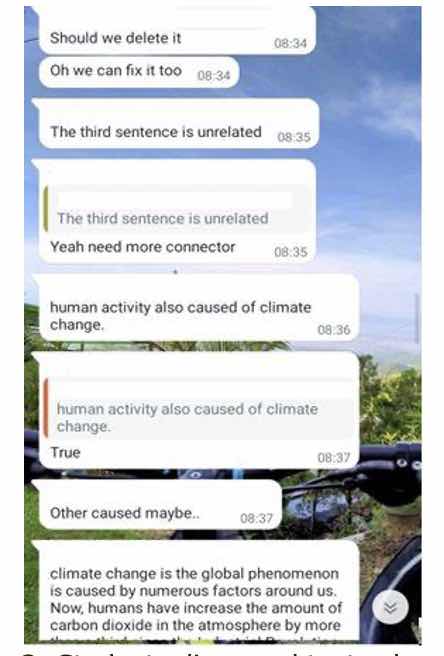
Figure 3: Students discussed text coherence

Figure 4: A student expressed her embarrassment.
As shown in Figure 3, each student had different ideas about different parts of the task which also encouraged each member to comment on peers’ ideas, enabling them to maintain mutual trust and tolerance throughout. In this case, different proficiency levels might interfere with one’s contribution, as exemplified in Figure 4. Being unable to address the content or discourse element of the paragraph, one student simply rectified typographical issues, which to her appeared inferior compared to her peers.
She expressed her feeling by posting an emoticon of a monkey covering its face, indicative of embarrassment as commonly expressed through similar gestures. Once the students finalized their learning product, they celebrated group accomplishment and appreciated each other’s contribution, marking their triumph after a series of trials. In harmony, the students’ reflections affirmed the value of MIM environment to encourage humanistic and democratic participation. Pevita mentioned that “[she] became confident to propose ideas and raise questions on the material to make sure that [she] understand the lesson. [She] would otherwise feel nervous in offline class”. Likewise, Zizou mentioned that “each individual was able to give comments and feedback without the fear of lacking confidence”.
These exchanges were not simply transactional in which everyone shared and refined their ideas, but also involved performative acts as they expressed their confusion and excitement. Using multimodal features, such as stylized spelling (e.g., ‘Okeey’), interjections (e.g., ‘Yeeahh’), and emoticons (e.g., ‘: v’ and ☹), allowed them to express their emotions and make explicit the message’s spirit as well as the discourse nuance. This portrayed students’ flourishing identities as language learners from non-English majors and whole individuals that exhibited their unique selves in relation to contoured learning episodes.
Banter and humor in academic discourse
This theme was contextualized in an Intensive Listening course. A task in the course required the students to complete a form, summary, and table. This episode was captured from one group in which one student mastered higher listening accuracy than his peers. In Figure 5, one student was dominant in that he directly shared complete answers to the task, which was surprising yet elating to his peers. The same student also produced the same promptness and comprehensive answers in another sub-task, while the others still grappled with the individual item.

Figure 5: The teacher teased the students on one member sharing complete answers
As a follow-up, the teacher teased the whole group about a student dominating the task by finishing the task only a few minutes after it had begun. This triggered mixed emotions in the rest of group, indicated by emoticons showing anxiety, sadness, and exhilaration.
In Figure 6, the teacher shared the feedback from the group work, with some remarks praising their work, as they had nine correct answers out of ten questions. Although the teacher’s initial intention was to pay credit to the whole group, one student translated the teacher’s remark into humor by addressing the compliment to his peer’s dominance by stating “ye(s) he is, sir, haha” in response to “you guys are still doing OK”. The student receiving appraisal from the whole group, however, addressed the teacher’s compliment to all members as he stated, “just compile all answers from group, sir”. In Figure 7, we can see everyone sharing the joy, not simply because of group achievement, but rather due to the student’s dominance, which consequently made the group work so much more effortless for the rest of the group. The inclusion of banter and humor resulted in a comfortable environment, compared to formal hierarchical interaction in a face-to-face classroom.
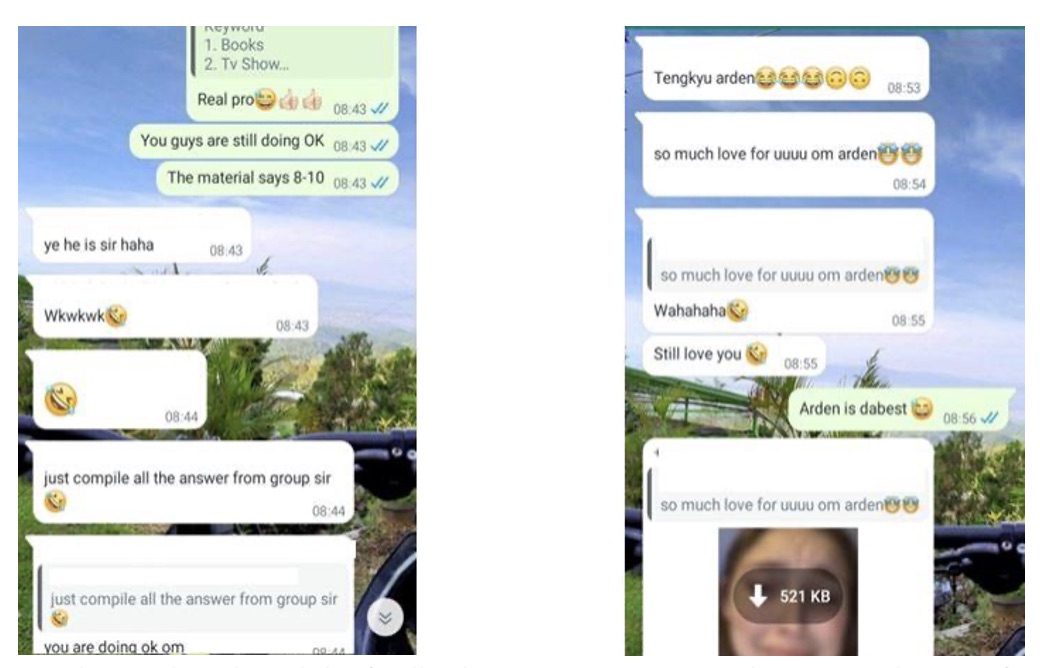
|
Figure 6: The teacher shared the feedback to the group work |
Figure 7: Students teased a peer for his dominant contribution |
Within this friendly environment, jocular exchanges were pivotal in not only initiating friendly interaction, but also in reducing tension, as documented in Figure 8. This episode took place in another group in the Intensive Listening course.

Figure 8: A student accidentally used a swear word
Due to strict time management and explicit scoring, students might feel frustrated due to the fear of failing to meet the deadline. For example, one of the students accidentally used a swear word signifying her disbelief to his peers informing the end of the discussion. Her peers and the teacher noticed the post containing swear word before deletion, yet such a generally impolite remark turned out to be light-hearted rather than worrisome. The interlacing of banter and humor helped develop teacher-students friendliness and diffuse tensions since this contributed to the affective dimension of this MIM-mediated interaction. This led to a stronger sense of trust and bonding since “friendly communication between teacher and students was there throughout the course, and the teacher cracked jokes at times. It helped [students] to understand the material” (Ivy).
Normalized informalities
The disclosure of students’ true identities and the growth of strong rapport between parties flattened the social hierarchy between the two, which served as the conduit for open, relaxed, and fluid interaction without undermining the teacher’s authority. This environment enabled the students “to run the discussion in [their own]) way. That nullified anxiety between members, so [they] found it easy to raise questions and partake in the discussion” (Andy). Another student also affirmed that “the students were able to build intimacy with the teacher instantaneously, which was essential to help understand the lesson” (Rocky). The following segments in the writing course documented the rise of normalized informality. Initially, the teacher greeted the group, as shown in Figure 9. He wrote “hieh” pronounced /’hɪə/ as in British English, rather than the standardized “here” to check whether each group member was online during the discussion. As one student perceived this jocular remark, he used a similar expression to confirm his presence.
These episodes documented students’ collaboration to compose a paragraph explaining global warming by using keywords dictated by the teacher. One student attempted the task and requested confirmation the correctness of his sentence (see Figure 10), to which the teacher put forward an explication of language aspect. Harmonious with the initial jocular exchanges, another student acknowledged the teacher's response by using unstandardized lettering, “klieh” pronounced /’klɪə/, as in the British version of “clear”.

Figure 9: The teacher checked students’ presence

Figure 10: A student requested confirmation
While maintaining positive rapport, such informality persisted throughout the discussion as students requested confirmation and feedback on their ongoing performativity. This was evident in Figure 11, in which the students expressed their surprise and disbelief as they noticed their scores.
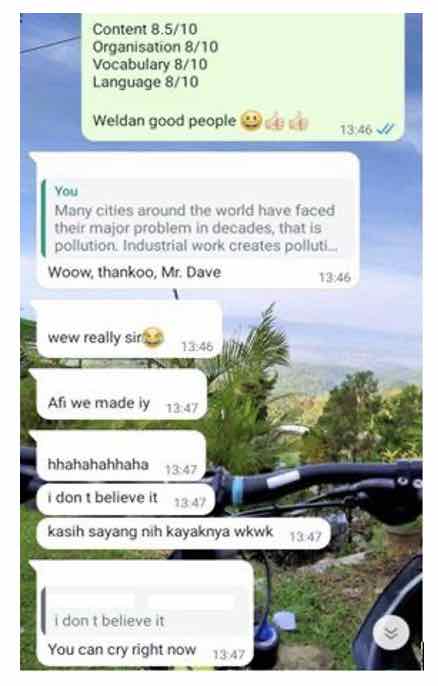
Figure 11: Students expressed excitement about their achievement
This last episode marked an ecstatic moment after the teacher awarded exemplary scores for the group’s performance. Despite the academic context and the presence of the teacher in this MIM-mediated communication, students used laughter, i.e., ‘hahahahaha’, several emoticons, e.g., ‘whew really, sir’ [EMOTICON] and [EMOTICON],and stylized spelling, e.g.,’thankoo’, to express their excitement. These digital exchanges mark the reconfiguration of interpersonal selves between parties and suspended formal stage-managed interaction, in favor of more fluid selves.
Discussion
Online learning engagement and learning achievement in TBML
The findings have acknowledged the technological and socio-constructivist affordances of MIM to support TBML. As the majority of the students are from Generation Z who want to be continuously connected, MIM offers the flexibility and connectivity to integrate their language learning with their personal and academic life. MIM helps to extend their learning engagement and sustain opportunistic learning as they can access their learning community and learning artifacts at any time (Andujar & Salaberri-Ramiro, 2019). Massive storage is also valuable to support the management of multimodal learning resources. Consistently updated across different learning episodes, these resources represent student-generated content personalized to their needs. When harnessed in collectivistic learning, the technological affordance extends the MIM potency as socio-constructivist affordances unfold through collaboration.
MIM caters to students’ needs to collaborate with their peers while encouraging their learning autonomy and self-efficacy (Annamalai, 2019; Çetinkaya & Sütçü, 2018). This collaboration empowers the students to keep up with the learning tasks in the learning community where they co-construct knowledge by sharing, comparing, and criticizing ideas. The collaboration links the internal cognitive process to social interaction (Lai, 2016; Lin et al., 2019), and this elevates enjoyment and self-esteem as students manage to complete tasks. In coherence with previous works (Awada, 2016; Lai et al., 2016), this engaging environment makes possible the meaning-making process through the authentic use of English. As they use the language as both medium and end of learning, they eventually perceive control and values of the mobile learning experience (Ma, 2017). Textual, pictorial, and aural language inputs encourage students to better take part in the discussion by compensating for limited linguistic repertoires, therefore enabling them to be more immersed in the social and academic dimensions of online learning (Kukulska-Hulme & Viberg, 2017).
As the students become increasingly active in group discussion and reflection, they perceive and acknowledge the values of learning the language to support their academic development. The discovery of emotional links with the MIM-mediated instruction stimulates their self-regulation because everyone gains the responsibility, control, and self-values in collaborative mobile learning. The more they give and receive support from their team, the more meaning they accord with their learning experiences. This collective growth is not the result of students’ collaboration per se. The co-presence between homework and entertainment is also valuable in reducing the perceived distance and emotional barriers to initiating learning sessions (Çetinkaya & Sütçü, 2018). Congruent with Tragant et al., (2022), this ambient space in which everyone shares the ups and downs of learning magnifies positive attitude and learning motivation. The feeling of belonging to a community encourages them to monitor their learning with their peers with whom they feel comfortable.
The multidimensional communication via MIM represents an authentic language learning experience. This unique communication coupled with the immediacy of (quasi) asynchronous communication coheres with SLA principles as outlined by Kukulska-Hulme & Viberg (2017). The archives of chats integrating different language skills and components constitute the collection of meaningful language inputs and outputs, which students can refer to for their consolidation of learning. With the permanence of MIM-mediated communication, students are enabled to notice their language features along with their inaccuracies. Prolonged periods of noticing and the negotiation of meaning draw learners’ attention to their language use, therefore leading to language acquisition, especially with teacher and peers’ feedback and scaffolding.
The construction of existential and relational authenticity
Our study has confirmed the potency of MIM-mediated environment for reproducing teacher and students’ existential and relational authenticity. This helps to develop transformative language learning in which teacher and students can co-negotiate learning trajectories and co-construct knowledge (Rambe & Mkono, 2019). In this environment students navigate their socio-cultural, academic, and political identities through MIM as a border-crossing object between formal and informal learning (Kukulska-Hulme & Lee, 2020). The engagement in TBML enables them to signify, disrupt, and reconfigure these layers of identities. Such engagement helps develop a comfortable zone for sharing and checking ideas in conversational nuance, especially due to the use of vernaculars, conversation-style chats, and jocular talks, representing an intersection between everyday life and study. The authentic environment is also characterized by the MIM social atmosphere where serendipitous learning intersects with the social mold integrating emoticons, comic laughter, stylized spelling, and interjections This lowers affective and motivational barrier to engaging in the lesson, thus helping the students to make the best of themselves.
The friendly exchanges in an authentic environment amplify rapport between interactants, without necessarily negating the teacher’s academic authority. MIM-mediated interaction affords the comfort of expressing students’ frustration and excitement. The grouping feature in WhatsApp certainly helps develop a safe locale for the students where they can share their contoured learning experiences and disclose their identity as foreign language learners. For such a liminal environment to arise, authentic relationships require the teacher to pay attention to students’ nervous episodes and confusion. The increased familiarity, the disruption of hierarchical relations, and the frankness of interaction have enabled MIM to flatten hierarchies (Raiman et al., 2017). However, sometimes maintaining proper interaction in virtual space can be difficult for both teacher and students, since interactants may interpret one message differently (Rambe & Mkono, 2019). This potential misinterpretation should be anticipated by the teacher to appropriate the compression of the power hierarchy. Otherwise, the teacher may perceive it as a denial of their academic authority.
The rise of normalized informalities in this environment discloses students’ true identity and allows the convergence of an individual’s agency since authentic exchanges minimize the formality of interaction. Starr (2008) contends that this disclosure of true identity and mutual trust between interactants helps to establish a sense of well-being, and therefore improves academic performance. This self-disclosure also helps the teacher to better understand students’ characteristics and adjust his instructional approach (Frego, 2006; Rambe & Mkono, 2019). Despite the naturally occurring power hierarchy, students and teacher should maintain positive interaction. The compression of authority should unveil with a fine balance between students’ avoidance of contempt and teachers’ management of the academic authority. Instead of using informality to diffuse teacher’s power, informality should be harnessed to construct and negotiate authority in a way that is conducive to supportive relationships and strong engagement. Teacher and students need to be cautioned that the exercise of authority and power is not necessarily malevolent per se, but instead, it needs to be viewed as a treasure to be discovered and appropriately harnessed, depending on the situation.
Conclusion
TBML has been shown to develop an authentic atmosphere where learners and teacher co-negotiate existential and relational authenticity in an engaging academic environment. The exchanges using multimodal inputs underscores the potency of MIM in stimulating enjoyable and friendly interaction, which is essential in reducing the affective barrier to learning engagement. Discussion and shared reflection create an authentic learning community where they can co-construct knowledge. This community has been proven fundamental to stimulating the growth of meaningful language input and output. As students’ progress through different tasks involving multiple language skills and components, they are guided to notice their language features and inaccuracies, leading to language acquisition. These technological and socio-constructivist affordances have been proven crucial to generating strong group engagement while allowing individual learners to improve their learning gains through the exposure to authentic English language use which is generally absent in their day-to-day communication.
About the existential and relational authenticity, unique integration of banter and humor adds to the frankness of communication and learning regulation, despite language-related challenges. The connectivity and immediacy of MIM afford the potential to transform the current online practices through collaborative elements and democratic participation. TBML can lead to the identification and amplification of learning agency. On this ground, learning is inherently social in that even specific rules are set up, the formal practices are still embedded and sustained by the social interaction. However, although collaboration via MIM holds a vital role to online learning engagement, this may otherwise be seen to threaten the entrenched pedagogical practices and policies. In addition, potential over-disclosure of true selves needs to be appropriately adjusted as the veneer of technology may mislead the students. As such, positive relational authenticity and collegial relation need to be finely attuned to common norms in teacher-students interaction. This raises one direction for future studies to scrutinize language teachers’ voices on their pedagogical experiences mediated by MIM as a key element to their online or blended teaching.
Careful attention needs to be paid to several limitations. First, the study did not identify students’ proficiency levels. Metrics in this regard would otherwise help to better understand the natures of engagement among groups or students with different proficiency levels. Likewise, due to the teacher’s encouragement to use English, the findings could not examine whether fluid and authentic communication was common features in all groups or only took place in the group with moderate or high proficiency levels. In addition, the study did not report on any causality mechanism between online learning engagement and learning achievement, as commonly documented through path analysis. Given the small research sample, the transfer of experience into the larger samples would warrant more generalizable insights into the integration of MIM, as would in-depth exploration concerning ethical issues in particular settings.
References
Abidin, Z., Mathrani, A., & Hunter, R. (2021). Teaching with technology: A lesson from social participation in an online learning community. Technology, Pedagogy and Education, 30(3), 381–392. https://doi.org/10.1080/1475939X.2021.1884128
Alshaibani, M. H., & Qusti, E. S. (2020). The role of smartphone app “WhatsApp” on achievement motivation and social intelligence among female undergraduate students. Perspectives in Psychiatric Care, 57(2), 597–603. https://doi.org/10.1111/ppc.12582
Andujar, A., & Salaberri-Ramiro, M. S. (2019). Exploring chat-based communication in the EFL class: Computer and mobile environments.Computer Assisted Language Learning, 34(4), 434-461. https://doi.org/10.1080/09588221.2019.1614632
Ankeny, R. (2019). Interweaving technology and language goals to promote academic vocabulary: The role of WhatsApp in an intensive English classroom. TESOL Journal, 10(3), 8–10. https://doi.org/10.1002/tesj.457
Annamalai, N. (2019). Using WhatsApp to extend learning in a blended classroom environment. Teaching English with Technology, 19(1), 3–20. https://tewtjournal.org/download/2-using-whatsapp-to-extend-learning-in-a-blended-classroom-environment-by-nagaletchimee-annamalai
Awada, G. (2016). Effect of WhatsApp on critique writing proficiency and perceptions toward learning. Cogent Education, 3(1), 1–25.https://doi.org/10.1080/2331186X.2016.1264173
Braun, V., & Clarke, V. (2006). Using thematic analysis in psychology. Qualitative Research in Psychology, 3(2), 77–101. https://doi.org/10.1191/1478088706qp063oa
Çetinkaya, L., & Sütçü, S. S. (2018). The effects of Facebook and WhatsApp on success in English vocabulary instruction. Journal of Computer Assisted Learning, 34(5), 504–514. https://doi.org/10.1111/jcal.12255
Council of Europe. (2001). Common European Framework of Reference for Languages: Learning, Teaching, Assessment. Council of Europe.
Cremades, R., Onieva-López, J. L., Maqueda-Cuenca, E., & J, Ramírez-Leiton, J. (2019). The influence of mobile instant messaging in language education: Perceptions of current and future teachers. Interactive Learning Environments, 29(5), 433-742. https://doi.org/10.1080/10494820.2019.1612451
Creswell, J. W., & Miller, D. L. (2020). Determining validity in qualitative inquiry. Theory into Practice, 39(3), 124–30. http://dx.doi.org/10.1207/s15430421tip3903_2
da Cunha, F. R., van Kruistum, C., & van Oers, B. (2016). Teachers and Facebook: Using online groups to improve students’ communication and engagement in education. Communication Teacher, 30(4), 228–241. https://doi.org/10.1080/17404622.2016.1219039
Diao, M., & Hedberg, J. G. (2020). Mobile and emerging learning technologies: Are we ready? Educational Media International, 57(3), 233–252. https://doi.org/10.1080/09523987.2020.1824422
Dixson, M. D. (2010). Creating effective student engagement in online courses: What do students find engaging? Journal of the Scholarship of Teaching & Learning, 10(2), 1–13. http://files.eric.ed.gov/fulltext/EJ890707.pdf
Du, Y. (2015). Information use and barriers on a mobile app in distance learning. Journal of Library & Information Services in Distance Learning, 9(3), 204–220. https://doi.org/10.1080/1533290X.2015.1052608
Frego, K. A. (2006). Authenticity and relationships with students. New Directions for Adult and Continuing Education, 2006(111), 41–50. https://doi.org/10.1002/ace.226
Gachago, D., Strydom, S., Hanekom, P. W., & Simons, S. (2015). Crossing boundaries: Lecturers’ perspectives on the use of WhatsApp to support teaching and learning in higher education. Progressio, 37(1), 172–187. https://doi.org/10.25159/0256-8853/579
Imamyartha, D., Wahjuningsih, E., Alifiyah, A., Santihastuti, A., Mitasari, Fauzie, D. L. T. A., & Andhika, E. C. H. (2022). EFL learners’ engagement and learning motivation in team-based mobile language learning through WhatsApp. Teaching English with Technology,22(1), 82–103.
Imamyartha, D., Wahjuningsih, E., Puspa, A., Bilqis, M., & Hudori, R. F. A. (2021). An experiment on mobile learning to leverage EFL learners’ engagement, emotional intelligence, and learning motivation. The Journal of Asia TEFL, 18(4), 1285–1301. https://doi.org/http://dx.doi.org/10.18823/asiatefl.2021.18.4.13.1285
Ke, L. (2010). Project-based college English: An approach to teaching non-English majors. Journal of Applied Linguistics, 33(4), 99–112.
Kern, R. (20). Perspectives on technology in learning and teaching languages. TESOL Quarterly, 40(1), 183-210. https://doi.org/10.2307/40264516
Kukulska-Hulme, A., & Lee, H. (2020). Mobile collaboration for language learning and cultural learning. In M. Dressman & R. W. Sadler (Eds.), The handbook of informal language learning (pp. 169–179). Wiley-Blackwell.
Kukulska-Hulme, A., & Viberg, O. (2017). Mobile collaborative language learning: State of the art. British Journal of Educational Technology, 49(2), 207-218. https://doi.org/10.1111/bjet.12580
Kukulska‐Hulme, A., Lee, H., & Norris, L. (2017). Mobile learning revolution: Implications for language pedagogy. In C. A. Chapelle & S. Sauro (Eds.), The handbook of technology and second language teaching and learning (pp. 217–233). Wiley.
Lai, A. (2016). Mobile immersion: An experiment using mobile instant messenger to support second-language learning. Interactive Learning Environments, 24(2), 277–290. https://doi.org/10.1080/10494820.2015.1113706
Levering, B. (2010). Phenomenology and existentialism. In P. Peterson, E. Baker, & B. McGaw (Eds.), International encyclopedia of education (3rd ed., pp. 80–85). Elsevier.
Lin, C.-C., Lin, V., Liu, G.-Z., Kou, X., Kulikova, A., & Lin, W. (2019). Mobile-assisted reading development: A review from the activity theory perspective. Computer Assisted Language Learning, 33(8), 833-864. https://doi.org/10.1080/09588221.2019.1594919
Ma, Q. (2017). A multi-case study of university students’ language-learning experience mediated by mobile technologies: A socio-cultural perspective. Computer Assisted Language Learning, 30(3–4), 183–203. https://doi.org/10.1080/09588221.2017.1301957
Maor, D. (2003). The teacher’s role in developing interaction and reflection in an online learning community. Educational Media International, 40(1–2), 127–138. https://doi.org/10.1080/0952398032000092170
Raiman, L., Antbring, R., & Mahmood, A. (2017). WhatsApp messenger as a tool to supplement medical education for medical students on clinical attachment. BMC Medical Education, 17. https://doi.org/10.1186/s12909-017-0855-x
Rambe, P., & Mkono, M. (2019). Appropriating WhatsApp-mediated postgraduate supervision to negotiate “relational authenticity” in resource-constrained environments. British Journal of Educational Technology, 50(2), 702–734. https://doi.org/10.1111/bjet.12688
Starr, S. S. (2008). Authenticity: A concept analysis. Nursing Forum, 43(2), 55–62. https://doi.org/10.1111/j.1744-6198.2008.00096.x
Taheri, H., Sadighi, F., Bagheri, M. S., & Bavali, M. (2019). EFL learners’ L2 achievement and its relationship with cognitive intelligence, emotional intelligence, learning styles, and language learning strategies. Cogent Education, 6(1). https://doi.org/10.1080/2331186X.2019.1655882
Tragant, E., Pinyana, À., Mackay, J., & Andria, M. (2022). Extending language learning beyond the EFL classroom through WhatsApp.Computer Assisted Language Learning, 35(8), 1946-1974. https://doi.org/10.1080/09588221.2020.1854310
van der Spoel, I., Noroozi, O., Schuurink, E., & van Ginkel, S. (2020). Teachers’ online teaching expectations and experiences during the Covid19-pandemic in the Netherlands. European Journal of Teacher Education, 43(4), 623–638. https://doi.org/10.1080/02619768.2020.1821185
Wang, C.-H., Shannon, D. M., & Ross, M. E. (2013). Students’ characteristics, self-regulated learning, technology self-efficacy, and course outcomes in online learning. Distance Education, 34(3), 302–323. https://doi.org/10.1080/01587919.2013.835779
Zhu, Q., & Wang, M. (2020). Team-based mobile learning supported by an intelligent system: Case study of STEM students. Interactive Learning Environments, 28(5), 543-559. https://doi.org/10.1080/10494820.2019.1696838
Zou, B., Li, H., & Li, J. (2018). Exploring a curriculum app and a social communication app for EFL learning. Computer Assisted Language Learning, 31(7), 694–713. https://doi.org/10.1080/09588221.2018.1438474

